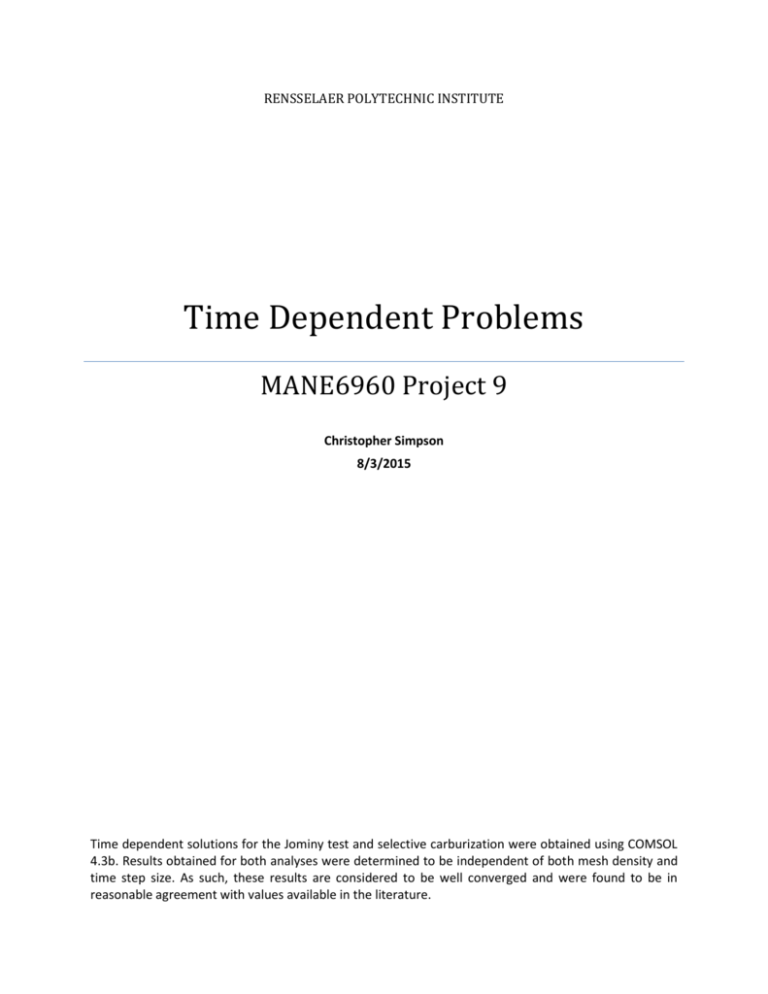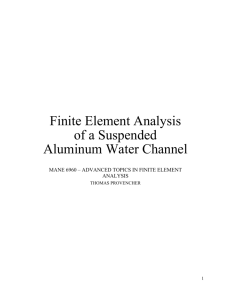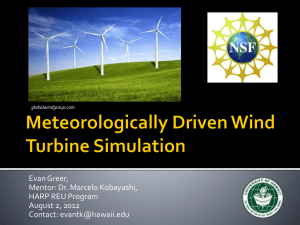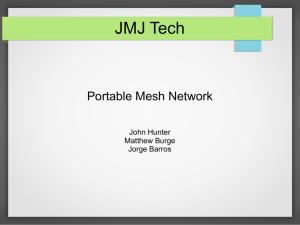HW09_report - Rensselaer Polytechnic Institute
advertisement

RENSSELAER POLYTECHNIC INSTITUTE Time Dependent Problems MANE6960 Project 9 Christopher Simpson 8/3/2015 Time dependent solutions for the Jominy test and selective carburization were obtained using COMSOL 4.3b. Results obtained for both analyses were determined to be independent of both mesh density and time step size. As such, these results are considered to be well converged and were found to be in reasonable agreement with values available in the literature. Contents Introduction .................................................................................................................................................. 2 Problem Statement ................................................................................................................................... 3 Finite Element Model.................................................................................................................................... 4 Mesh ......................................................................................................................................................... 4 Analysis Results ............................................................................................................................................. 6 Discussion and Conclusions ........................................................................................................................ 10 References .................................................................................................................................................. 10 List of Figures Figure 1: Problem Definition, Jominy Test .................................................................................................... 3 Figure 2: Problem Definition, Selective Carbuization ................................................................................... 4 Figure 3: Jominy Test Mesh Details .............................................................................................................. 5 Figure 4: Selective Carburization Mesh Details ............................................................................................ 5 Figure 7: Temperature Time Evolution, Jominy Test (Temp in Kelvin) ......................................................... 6 Figure 8: Effect of Mesh Density on Jominy Test Results ............................................................................. 7 Figure 9: Effect of Time Step Size on Jominy Test Results ............................................................................ 7 Figure 10: Carbon Concentration Time Evolution......................................................................................... 8 Figure 11: Effect of Mesh Density on Results, Selective Carburization ........................................................ 9 Figure 12: Effect of Time Step on Results, Selective Carburization .............................................................. 9 Introduction The Jominy test is an important method for determining the hardenability of steels. This test, specified by the ASTM, measures the capacity of, and the extent to which, a given alloy will cool and harden when quenched. This test involves bringing a cylindrical sample up to heat treatment temperatures used to establish a uniform microstructure (typically 800-1000°C) and subsequently cooling a single face of the sample using a liquid jet. The hardness of the cooled sample is then tested to characterize the alloy’s hardenability. The heat balance of this process is represented below, where Q encompasses all convective heat transfer terms introduced by air and liquid cooling. The below equation will be solved using the COMSOL heat transfer module. Selective carburization is a diffusion process by which carbon atoms penetrate a substrate alloy to modify its mechanical and/or chemical properties only at desired locations. The use of a mask or defines a surface of the substrate over which these carbon atoms may or may not penetrate. The diffusion process follows Fick’s Law, where the time evolution of the concentration of a given species is governed by the spatial concentration gradient in the system as indicated below. We assume all coefficients with the exception of the mass and diffusion terms vanish. This simplification results in the equation below, which will be solved using the COMSOL mathematics module. Problem Statement The Jominy test problem was solved using the COMSOL heat transfer package assuming 2D axisymmetry. The boundary conditions and material properties of the Jominy test problem were as indicated in Figure 1, with the geometry of the sample as specified per ASTM test standards. Convective heat transfer coefficients and initial conditions were assumed using approximate values from Wang et al[1]. It should be noted that heat transfer coefficients were taken to be constant across all temperatures as a first approximation. Water was assumed to boil on contact thus keeping the temperature at 100°C. Stainless Steel AISI 4030 was used as its material properties are readily available in the built in COMSOL materials library. Figure 1: Problem Definition, Jominy Test The selective carburization analysis was solved using the coefficient form of the general PDE contained within COMSOL’s mathematics package. Again, 2D axisymmetry was assumed for this problem using an initially carbon-free sample of radius 12.5 mm and height 25 mm. All exterior surfaces of the sample were masked with the exception of one as indicated in Figure 2 . The influx of carbon was modeled using a Neumann boundary condition, setting the time derivative of the concentration equal to the spatial concentration gradient. The general form of the PDE solved using COMSOL is shown in the previous section; all except the mass and diffusion coefficients were assumed to be zero for this analysis. Values of diffusivity, mass transfer coefficient, and carbon potential were selected using values similar to those presented in Mutchler and Tibbets[2],[3]. Figure 2: Problem Definition, Selective Carbuization Finite Element Model Mesh 2D axisymmetric finite element models were created using COMSOL 4.3b. For each problem, three meshes were created (coarse, medium, and fine) to assess the impact of mesh density on relevant results. The domains of both the Jominy test model and of the selective carburization model were subdivided to obtain results at specific locations. All meshes were created using 4-noded quad elements with default quadratic shape functions and are shown in Figure 3 and Figure 4. Figure 3: Jominy Test Mesh Details Figure 4: Selective Carburization Mesh Details Analysis Results The results of the Jominy test analysis are shown in Figure 5. These results indicate the time evolution of the temperature of the sample over the course of a full minute. As expected, the bulk temperature of the sample is shown to decrease, being coldest at the surface in contact with water spray. Figure 5: Temperature Time Evolution, Jominy Test (Temp in Kelvin) The temperature at three points along the length of the sample was recorded for all three mesh sizes as a function of time and is shown in Figure 6. As can be seen in Figure 6, the effect of mesh density is so small as to be neglected for the analysis conducted; very little variation was observed in these results. It should be noted that all of these results were obtained using the default time step setting imposed by COMSOL. Understanding that the mesh density does not play a significant role in obtaining results, further studies were conducted on time step control on the medium mesh model. For comparison to default behavior, the maximum time step was restricted to 0.1 and 0.01 seconds. This again resulted in negligible differences as compared to the baseline analysis, indicating that the results may be considered reasonably well converged regarding both time step and mesh density. Noting that there were very minor differences in the results, an initial time step of 5 seconds was imposed on the model. Only this change resulted in notable differences, but only in the early stages of the analysis. Subsequent stages of the analysis converged towards all other solutions, indicating that the default time step controls within COMSOL are quite sufficient for the Jominy test problem. Figure 6: Effect of Mesh Density on Jominy Test Results Figure 7: Effect of Time Step Size on Jominy Test Results The time evolution of the carbon concentration in a masked sample is shown in Figure 8 over a full minute. These results are shown to be in fair agreement with those presented by Mutchler, indicating that some carbon does indeed penetrate below the mask and will continue to penetrate given sufficient time and environmental conditions (i.e. concentration potential). Figure 8: Carbon Concentration Time Evolution The effect of mesh density on these results is summarized in Figure 9. As can be seen in the figure, the concentration at the point indicated was not shown to change significantly with increasing mesh density and therefore may be considered reasonably well converged, achieving a maximum value of approximately 22%. However, these results are rather “noisy”, indicating some oscillation about a mean value. Such behavior warranted an investigation of the time step controls. The effect of changing the time step was investigated by restricting the time step to two extremes; 5 seconds and 0.01 seconds. As shown in Figure 10, reducing the time step eliminated the oscillation in the results as compared to the baseline and to the 5 second time step analyses. That being said, the mean value was shown not to change significantly with the choice of time step. The results may therefore be considered reasonably well converged in both regards. Figure 9: Effect of Mesh Density on Results, Selective Carburization Figure 10: Effect of Time Step on Results, Selective Carburization Discussion and Conclusions Time dependent solutions for the Jominy test and selective carburization were obtained using COMSOL 4.3b. Results obtained for both analyses were determined to be independent of both mesh density and time step size. As such, these results are considered to be well converged and were found to be in reasonable agreement with values available in the literature. In both cases, the default time step controls implemented by COMSOL were found to be adequate to obtain reasonable results. Although these default settings produced some oscillations for the selective carburization analysis, the mean value about which those values oscillated was found to be in agreement with the value obtained with a more refined time step size. No such oscillation was observed for the Jominy test analysis. References 1. 2. 3. 4. Wang et al. Computational Modeling of a Jominy Test Mutchler et al. A Study of the Selective Carburization Process Tibbets, Gary G. Diffusivity of Carbon in Iron and Steels at High Temperatures Course Notes, MANE6960: Advanced Topics in Finite Elements. Rensselaer Polytechnic Institute Summer 2015








